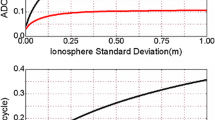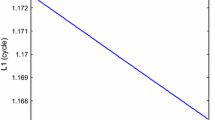Abstract
Cycle slip detection is one of the essential steps for high-precision GNSS data processing when carrier phase observations are involved, such as in precise point positioning (PPP) and precise orbit determination (POD). A number of algorithms have been developed since the 1980s and are effective for processing dual-frequency GPS. However, the emerging BeiDou navigation satellite system in China brings some new challenges for these existing algorithms, especially when small cycle slips occur more frequently. In this study, a large number of 1-cycle slips have been found in low-elevation BeiDou GEO carrier phase observations, which are collected by receivers of the IGS multi-GNSS experiment. Such small cycle slips should be identified and repaired, if possible, before PPP and POD processing. We propose an enhanced cycle slip detection method based on the series of dual-frequency phase geometry-free combinations. A robust polynomial fit algorithm and a general autoregressive conditional heteroskedastic modeling technique is employed to provide an adaptive detection threshold, which allows identification of such small cycle slips with high reliability. Simulated and real data tests reveal that the proposed method has both high sensitivity and low false-alarm rate even in the case of ionospheric scintillation.












Similar content being viewed by others
References
Banville S, Langley RB (2013) Mitigating the impact of ionospheric cycle slips in GNSS. J Geod 87(2):179–193. doi:10.1007/s00190-012-0604-1
Blewitt G (1990) An automatic editing algorithm for GPS data. Geophys Res Lett 17(3):199–202. doi:10.1029/GL017i003p00199
Bollerslev T (1986) Generalized autoregressive conditional heteroskedasticity. J Econom 31(3):307–327
Cai C, Liu Z, Xia P, Dai W (2013) Cycle slip detection and repair for undifferenced GPS observations under high ionospheric activity. GPS Solut 17(2):247–260. doi:10.1007/s10291-012-0275-7
Chen D, Ye S, Zhou W et al (2016) A double-differenced cycle slip detection and repair method for GNSS CORS network. GPS Solut 20(3):439–450. doi:10.1007/s10291-015-0452-6
CSNO (2013) BeiDou navigation satellite system signal in space interface control document, Open Service Signal (Version 2.0). China Satellite Navigation Office (CSNO), December 2013
de Lacy MC, Reguzzoni M, Sansò F, Venuti G (2008) The Bayesian detection of discontinuities in a polynomial regression and its application to the cycle-slip problem. J Geod 82:527–542. doi:10.1007/s00190-007-0203-8
de Lacy MC, Reguzzoni M, Sansò F (2012) Real-time cycle slip detection in triple-frequency GNSS. GPS Solut 16(3):353–362. doi:10.1007/s10291-011-0237-5
Goad C (1985) Precise positioning with the global position system. In: Proceedings of 3rd international symposium on inertial technology for surveying and geodesy, pp 745–756
Guo J, Xu X, Zhao Q, Liu J (2016) Precise orbit determination for quad-constellation satellites at Wuhan University: strategy, result validation, and comparison. J Geod 90(2):1–17. doi:10.1007/s00190-015-0862-9
Hatch R (1982) The synergism of GPS code and carrier measurements. In: Proceedings of the third international symposium on satellite Doppler positioning at Physical Sciences Laboratory of New Mexico State University, 8–12 Feb, vol 2, pp 1213–1231
Huang L, Lu Z, Zhai G et al (2016) A new triple-frequency cycle slip detecting algorithm validated with BDS data. GPS Solut 20(4):761–769. doi:10.1007/s10291-015-0487-8
Ji S, Chen W, Weng D, Wang Z, Ding X (2013) A study on cycle slip detection and correction in case of ionospheric scintillation. Adv Space Res 51(2013):742–753. doi:10.1016/j.asr.2012.10.012
Kleusberg A, Georgiadou Y, van den Heuvel F, Heroux P (1993) GPS data preprocessing with DIPOP 3.0. Internal technical memorandum, Department of Surveying Engineering, University of New Brunswick, Fredericton, New Brunswick, Canada
Liu Z (2011) A new automated cycle slip detection and repair method for a single dual-frequency GPS receiver. J Geod 85(3):171–183. doi:10.1007/s00190-010-0426-y
Montenbruck O, Hauschild A, Steigenberger P, Hugentobler U, Teunissen P, Nakamura S (2013) Initial assessment of the COMPASS/BeiDou-2 regional navigation satellite system. GPS Solut 17(2):211–222. doi:10.1007/s10291-012-0272-x
Montenbruck O, Steigenberger P, Khachikyan R, Weber G, Langley RB, Mervart L, Hugentobler U (2014) IGS-MGEX: preparing the ground for multi-constellation GNSS science. Inside GNSS 9(1):42–49
Rousseeuw PJ, Croux C (1993) Alternatives to the median absolute deviation. J Am Stat Assoc 88(424):1273–1283. doi:10.1080/01621459.1993.10476408
Wu Y, Jin S, Wang Z, Liu J (2010) Cycle slip detection using multi-frequency GPS carrier phase observations: a simulation study. Adv Space Res 46(2):144–149. doi:10.1016/j.asr.2009.11.007
Xu PL (2005) Sign-constrained robust least squares, subjective breakdown point and the effect of weights of observations on robustness. J Geod 79:146–159. doi:10.1007/s00190-005-0454-1
Zhang X, Li P (2016) Benefits of the third frequency signal on cycle slip correction. GPS Solut 20(3):451–460. doi:10.1007/s10291-015-0456-2
Acknowledgements
This research was supported by the National Natural Science Foundation of China (Nos. 61573367, 61370013, and 91438202) and the international GNSS Monitoring & Assessment System (iGMAS) data center. The authors would like to thank the IGS Multi-GNSS Experiment (MGEX) project for providing the GNSS data used in this research.
Author information
Authors and Affiliations
Corresponding authors
Rights and permissions
About this article
Cite this article
Ju, B., Gu, D., Chang, X. et al. Enhanced cycle slip detection method for dual-frequency BeiDou GEO carrier phase observations. GPS Solut 21, 1227–1238 (2017). https://doi.org/10.1007/s10291-017-0607-8
Received:
Accepted:
Published:
Issue Date:
DOI: https://doi.org/10.1007/s10291-017-0607-8




